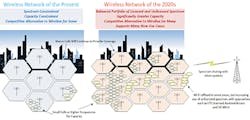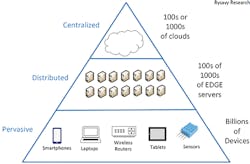5G’s Transformational Journey Is a Marathon, Not a Sprint —
For years, the promise of 5G has been dangling in front of us, with visions of being able to change the world. Its ability to greatly improve network speeds, manage more devices, have better coverage, use more spectrum, be more energy efficient, and offer lower network latency have profound implications across every industry with social, economic, and technological effects.
Network operators and equipment manufacturers have been working furiously in the labs and in the field. Countless engineers, testers, network architects, and technicians, have spent untold hours to bring us to this point: 5G is here now. It is now a commercial reality at the very beginning of its technological lifetime.
Successful Beginning
The past few months of 5G commercial network launches have been a whirlwind of interest for the wireless industry. As of August 2019, there were 29 commercial networks launched worldwide that adhered to 3GPP standardized 5G technology, according to research firm TeleGeography (https://www.telegeography.com/). That number is anticipated to grow to about 50 commercial 5G networks worldwide by the end of 2019.
InvisiLight® Solution for Deploying Fiber
April 2, 2022Go to Market Faster. Speed up Network Deployment
April 2, 2022Episode 10: Fiber Optic Closure Specs Explained…
April 1, 2022Food for Thought from Our 2022 ICT Visionaries
April 1, 2022These 5G networks will handle the explosive growth of mobile data. Cisco forecasts that by 2022, nearly 12% of global mobile traffic will come from 5G, which equates to over 422 million 5G capable devices generating approximately 21 GB of traffic per month. The intensity of the traffic equates to 46% annual growth and an estimated 3.9 billion IoT connections by 2022.
How will 5G networks be able to handle all the increased demand for mobile wireless data? According to Rysavy Research (https://rysavy.com/), wireless network capacity doubles every 3 years. Expanding capacity of the networks is being driven by more (and more efficiently used) spectrum, increased density of cells, smarter antennas, increased fiber density, and improved core and edge network architecture.
These efforts are resulting in 5G networks that offer several improvements over existing 4G LTE networks. 5G has improved network capacity and throughput with peak data speeds up to 20 Gbps downlinks and up to 10 Gbps uplinks. It will have standardized network architecture to support up to 1 million devices per square kilometer, and manage devices that are moving up to 500 kilometers per hour.
In addition, a fully developed 5G network can be over 100 times as energy-efficient as a 4G LTE network, while offering 1 millisecond network latency time. 5G also offers spectrum support for many frequencies, including spectrum bands above 6 GHz (millimeter wave), availability of Time Division and Fixed Division Duplex (TDD and FDD) communications modes, and use of both licensed and unlicensed spectrum.
Moreover, the transition to 5G has been happening simultaneously with continued advances in 4G LTE. Because 5G New Radios (5G NR) interoperate with 4G networks, they can be integrated on top of them — which means 5G is delivering its enhancements while 4G LTE continues to be built up.
While 5G is being built, 4G LTE continues to be enhanced with a variety of technologies like Gigabit LTE with Licensed Assisted Access (LAA), Carrier Aggregation, Voice-over-LTE (VoLTE), unlicensed band integration, virtualization and high order Multi-In Multi-Out (MIMO). The result is a multi-generational seamless wireless network of the 2020s that will see greater densification of small cells that can operate at higher spectrum frequencies, such as millimeter wave, for capacity. (See Figure 1.)
Figure 1. Network Transformation
5G Impacts on Cities and the Enterprise
Indeed, 5G can change industries like retail by providing new brick and mortar experiences, the automotive industry with intelligent traffic systems, manufacturing with smart factories, and health care with telemedicine done over 5G networks.
Infrastructure vendors are even using 5G in their own factories to make even more 5G products!
Autonomous vehicles get a boost with 5G cellular V2X technologies that enable do-not-pass warnings, blind-curve hazard warnings, road-works warnings, blind-intersection assistance, coordinated driving with intention sharing, coordinated trains of vehicles (platooning), bicyclist and pedestrian alerts, sensor sharing, left-turn assistance, and real-time driving.
Public safety will build on LTE improvements that enable video and data, proximity-based services, prioritization on congested networks, high-power user equipment, isolated operations, and relays.
With these types of improvements, 5G network operators and equipment manufacturers are already exploring new revenue models.
• What partnerships could occur with the impact that mobile video had on the industry?
• What new markets could arise with Artificial Intelligence (AI)-enabled image-recognition capabilities built into 5G sensors?
• How could drones send gigabytes of video data back on 5G networks to cloud or edge servers?
The Fourth Industrial Revolution technologies of 5G, AI, IoT, cloud and edge computing, robotics, and digital medicine, are truly beginning to converge. According to a Deloitte study, 5G will facilitate many emerging technologies — such as autonomous vehicles, mobile payments, and remote monitoring and control. It reported around 80% of the businesses are already prepared for the disruptions that emerging technologies could cause in the next 3 years. (See Figure 2.)
Figure 2. Intelligence in the Cloud, the Edge, and in Devices. Growing complexity requires fast, comprehensive, resilient & responsive 5G networks.
At the same time, 5G and wireless networks are also being impacted by these same technologies, just as much as it’s enabling them. Technologies are re-inventing the way networks are architected. Key technologies such as AI, Virtualization, Edge Computing, Massive MIMO, and information-centric networking, are radically altering the architecture and functionality of today’s wireless networks.
For instance, AI and machine learning are being used to manage the growing complexity of 5G networks. Multiple companies that specialize in software-defined networking (SDN) are applying principles of cloud computing to the network.
The Roadmap Takes Time
Figure 3. Roadmap to complete 5G. Rysavy Research: The 5G Timeline.
The roadmap to full-featured 5G will continue to change with new enhancements over the next decade. Full-featured 5G is occurring in multiple phases. (See Figure 3.)
• Phase I (Release 15) was completed in 2019. Phase I — operate in any frequency band; support LTE and 5GNR including dual connectivity; massive MIMO, beamforming; improved carrier aggregation; future proofing; comprehensive security architecture; network slicing.
• Phase II (Release) 16 is underway. This means: unlicensed below 7 GHz; integrated access and backhaul; industrial IoT; NR-based Cellular Vehicle-to-Everything (C-V2X); commercial and regulatory uses; device energy efficiency; satellite network studies.
• (Release 17) is expected to be completed in 2021. Release 17 includes: NR-light for wearables and IoT with power saving; operation above 52.6 GHz; multi-SIM operation; new radio multicast and broadcast; support for unmanned aerial vehicles and satellite; more industrial IoT; sidelink for V2X, commercial and critical comms; multiple improvements in MIMO, coverage, integrated access backhaul (IAB), unlicensed operation, positioning.
As 5G develops over the next decade, even more improvements will occur across the radios, networks, distributed computer intelligence, and standards. (See Figure 3.) Peak throughput speeds could reach 1 terabit per second. Typical speeds could be in the hundreds of gigabits per second.
Wireline broadband replacement could be viable for nearly all users. Super high resolution will be available. Immersive telepresence and 3D holographic capabilities will emerge. 99.9999999% (Nine "nines") of network uptime reliability will be achievable. In terms of latency, even greater timing precision will be possible.
As you can see, the future of 5G wireless communications is very bright. Much like the "overnight Hollywood sensation" who has taken 10 years toiling away to hone his or her craft, the development of 5G networks has been years in the making.
The next 10 years will see even more technological improvements that will have long-lasting social and economic affects.
Like this Article?
Subscribe to ISE magazine and start receiving your FREE monthly copy today!
Resources and Notes
This article is based on the 5G Americas white paper Global 5G: Implications of a Transformational Technology, provided by Rysavy Research (http://www.rysavy.com); it utilized a composite of statistical information from multiple resources. Published September 2019. For more information, please visit https://www.5gamericas.org/global-5g-implications-of-a-transformational-technology/.
5G Americas maintains market information, LTE deployment lists, and numerous white papers, available for free download at https://www.5gamericas.org/.
Cisco Visual Networking Index: Forecast and Trends, 2017-2022 White Paper. Cisco. Updated February 27, 2019. Document ID 1551296909190103. https://www.cisco.com/c/en/us/solutions/collateral/service-provider/visual-networking-index-vni/white-paper-c11-741490.html
2019 Annual Survey Highlights. CTIA. https://api.ctia.org/wp-content/uploads/2019/06/2019-Annual-Survey-Highlights-FINAL.pdf
Forbes. "How 5G Could Impact The Brock-And-Mortar Experience" by Sunil Kumar, Forbes Council Member, CEO at GroundTruth. August 6, 2019. https://forbes.com/sites/forbesagencycouncil/2019/08/06/how-5g-could-impact-the-brick-and-mortar-experience/#3ae3429a344d
Traffic Technology Today.com. "Applied Information adds C-V2X technology to its traffic products" by Adam Frost, News Editor of TTT. April 15, 2019. https://www.traffictechnologytoday.com/news/its/applied-information-adds-c-v2x-technology-to-its-traffic-products.html
Machine Design. "How to Digitally Transform your Factory" by David Nowoswiat, Sr., a senior product and solutions marketing manager for Nokia. July 18, 2019. https://www.machinedesign.com/industrial-automation/how-digitally-transform-your-factory
World Economic Forum. "Fourth Industrial Revolution".
https://www.weforum.org/agenda/archive/fourth-industrial-revolution
MartechSeries Marketing Technology Insights. Deloitte. https://martechseries.com/tag/deloitte/
TechRadar. "5G reveals the road to self-driving vehicles" by Daniel Ruiz, CEO of Zenzic. 2019-08-09T14:39:36Z. https://www.techradar.com/news/5g-reveals-the-road-to-self-driving-vehicles
Financial Express. "Powering next-generation networks with Artificial Intelligence" by Nitin Bansal, Head of Ericsson India and Head of Networks Solutions, Market Area Southeast Asia, Oceania and India. Published August 5, 2019, 10:53:08 AM. https://www.financialexpress.com/industry/technology/powering-next-generation-networks-with-artificial-intelligence/1666269/












